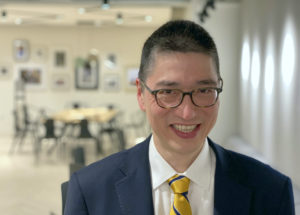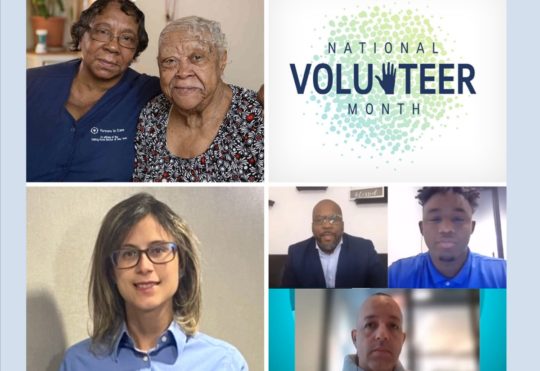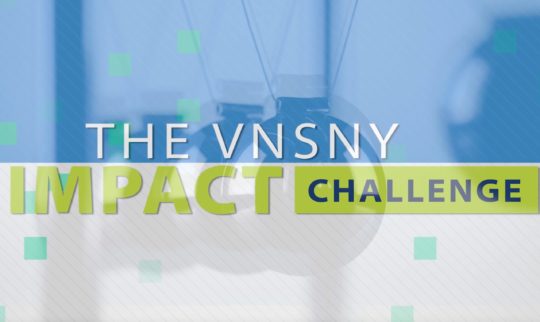UHF Honors Tim Peng for Work with VNSNY’s Business Intelligence & Analytics Team on Medicaid Payment Reform
 Tim Peng, Chief Data Analytics Officer and head of VNSNY’s Business Intelligence & Analytics (BIA) group, has been honored by the United Hospital Fund (UHF) as one of the recipients of its 2020 Excellence in Health Care Award. The award, given to “outstanding individuals whose vision and accomplishments are driving improvements across the full continuum of care,” was presented to Tim and his fellow awardees in a virtual celebration on July 13th.
Tim Peng, Chief Data Analytics Officer and head of VNSNY’s Business Intelligence & Analytics (BIA) group, has been honored by the United Hospital Fund (UHF) as one of the recipients of its 2020 Excellence in Health Care Award. The award, given to “outstanding individuals whose vision and accomplishments are driving improvements across the full continuum of care,” was presented to Tim and his fellow awardees in a virtual celebration on July 13th.
Tim was recognized for his work with the BIA team and others at VNSNY to design a fairer Medicaid reimbursement model. Thanks to this work, VNSNY CHOICE will now be able to provide the comprehensive services to its sickest and most vulnerable members that it is known for, without concerns that it will lose money on these services because of inadequate payments from Medicaid.
“Basically, sicker clients need more services,” says Tim. “Mission-driven not-for-profits like VNSNY were in an untenable position under the old model, because we serve more members who have highly complex health issues and severe disabilities than other plans.”
Drawing on Data and Experience to Fix a Complex Problem
Specifically, Tim was honored as one of this year’s UHF Quality Improvement Champions for VNSNY’s role advising the New York State Department of Health (DOH) and its actuary, Deloitte, on a new risk-adjustment payment model for Medicaid managed long-term care plans (MLTCs). This new model does a better job of taking into account factors that reflect the needs of MLTC members—particularly frail and complex Medicaid recipients—including members of VNSNY’s own CHOICE MLTC plan.
The BIA team worked for two years devising a fix to the problem, with support from Dr. Hany Abdelaal, President of VNSNY CHOICE, CHOICE Financial Planning and Analysis, and VNSNY’s Government Affairs (GA) team. Laura White, Manager of Data Science for BIA, conducted a series of analyses of CHOICE members to identify where improvements could be made to better align payment to services. In one analysis, she found that members who required ventilators, those who suffered from Alzheimer’s or dementia, and/or those who required more than 12 hours of care per day had costs of care that were not adequately recognized in the risk adjustment model.
“At the end of the day, the goal was straightforward—better aligning the state’s long-term care payment policies with members that needed the most care,” says Tim. “To do that, we used our data to look at our members and figure out what wasn’t working. It’s not just that we know how to keep clients out of the hospital. We can also describe the pattern of costs and services needed to care for them safely at home.”
“We have a strong partnership with the New York State Department of Health, and we look for opportunities to collaborate on issues where we can provide value and where our recommendations support sound public policy,” said Ann Mary Ferrie, Associate Director of Government Affairs and Public Policy, who led GA’s participation in the project. “This was a clear example of that alignment.”
At the end of the process, the BIA team came up with 39 specific suggestions presented in eight broad categories of recommendations for Deloitte and DOH, and the state went on to incorporate the suggestions in seven of their eight categories. Those changes went into effect last fall.
“A Truly Collective Effort”
Tim is quick to note that the UHF award really belongs to a broad group at VNSNY, including the individuals and teams mentioned above. “The project was a truly collective effort,” he says. “We were only able to succeed because of the efforts of so many people in the BIA group and others throughout VNSNY and CHOICE.”
In addition to carrying out projects like this one, the 45-person BIA Department plays an important role in all aspects of VNSNY’s daily operations, analyzing every piece of data that VNSNY generates. That analysis is then used for everything from developing staff dashboards to fulfilling regulatory requirements.
In the spring, Tim and his team played a critical role in VNSNY’s response to COVID-19. Because the virus was so new and things were moving so fast, “No one had time to even guess what they needed, so we tried to anticipate it,” he recalls. “We built dashboards to help us understand COVID and how our clients were responding, what care they needed, and if they were avoiding care out of fear.”
Whether it involves a crisis like COVID-19 or the challenges the entire VNSNY staff faces every day, Tim emphasizes that his team and the data they collect are there to support VNSNY’s mission. “In everything we do,” he says, “we constantly ask ourselves, how can we help guide the organization in better understanding our clients, especially the ones at highest risk—and how can we help our clinical teams stay safe, and deliver the best possible care?”

